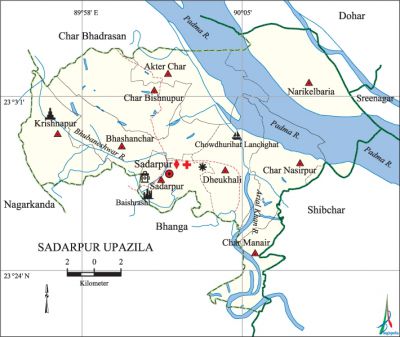Sadarpur Upazila
Sadarpur Upazila (faridpur district) area 290.20 sq km, located in between 23°24' and 23°34' north latitudes and in between 89°57' and 90°11' east longitudes. It is bounded by char bhadrasan and dohar upazilas on the north, bhanga upazila on the south, shibchar and sreenagar upazilas on the east, nagarkanda upazila on the west.
Population Total 188757; male 94982, female 93775; Muslim 177779, Hindu 10946, Buddhist 9, Christian 11 and others 12.
Water bodies Main rivers: padma, arial khan, Bhubaneshwar.
Administration Sadarpur Thana was formed in 1863 and it was turned into an upazila in 1984.
| Upazila | ||||||||
| Municipality | Union | Mouza | Village | Population | Density (per sq km) | Literacy rate (%) | ||
| Urban | Rural | Urban | Rural | |||||
|
-
|
9
|
88
|
296
|
5548
|
183209
|
650
|
54.5
|
35.8 |
| Upazila Town | ||||||||
|
Area (sq km)
|
Mouza
|
Population
|
Density (per sq km)
|
Literacy rate (%)
| ||||
|
3.01
|
2
|
5548
|
1843
|
54.5 | ||||
| Union | ||||
| Name of union and GO code | Area (acre) | Population | Literacy rate (%) | |
| Male | Female | |||
|
Akter Char 9
|
8092
|
10586
|
11426
|
34.55
|
|
Krishnapur 66
|
7011
|
16491
|
15785
|
38.01
|
|
Char Nasirpur 47
|
6791
|
7615
|
6442
|
34.69
|
|
Char Bishnupur 28
|
8525
|
10325
|
11135
|
33.72
|
|
Char Manair 38
|
10583
|
6818
|
6656
|
34.36
|
|
Dheukhali 57
|
6828
|
11386
|
11299
|
35.51
|
|
Narikelbaria 76
|
11482
|
7898
|
7522
|
17.93
|
|
Bhashanchar 19
|
10938
|
11482
|
11533
|
33.45
|
|
Sadarpur 85
|
4027
|
12381
|
11977
|
53.65 |
Source Bangladesh Population Census 2001, Bangladesh Bureau of Statistics.

Archaeological heritage and relics Residence of Baishrashi Zamindar (Roy Bahadur Rajendra Ray Chowdhury), Krishnapur Kali Mandir, Baishrashi Math, Baishrashi Shiva Sundari Academy.
Literacy rate and educational institutions Average literacy 36.3%; male 40.3%, female 32.4%. Educational institutions: college 2, secondary school 21, primary school 117, madrasa 8. Noted educational institutions: Krishnapur Primary School (1910), Baishrashi Shiva Sundari Academy (1914).
Religious institutions Mosque 294, temple 14, khanqah 3.
Cultural organisations Library 2, club 38, cinema hall 1, literary organisation 3, women organisation 2, playground 8.
Main sources of income Agriculture 67.79%, non-agricultural labourer 2.33%, industry 0.74%, commerce 11.41%, transport and communication 2.42%, service 5.68%, construction 0.70%, religious service 0.11%, rent and remittance 3.25% and others 5.57%.
Ownership of agricultural land Landowner 66.33%, landless 33.67%; agricultural landowner: urban 54.02% and rural 66.69%.'
Main crops Paddy, jute, oil-seed, pulse, vegetables.
Extinct or nearly extinct crops Kusumphul, kaun, kalijira, tobacco, china, sanpat.
Main fruits Jackfruit, palm, blackberry, coconut, sapodilla, date.
Fisheries, dairies and poultries Fishery 80, poultry 40, hatchery 4.
Communication facilities Pucca road 110 km, semi-pucca road 55 km, mud road 410 km; waterway 60 nautical miles.
Extinct or nearly extinct traditional transport Palanquin, horse carriage.
Noted manufactories Rice mill, flour mill, oil mill, Spinning mill, ice factory, welding factory.
Cottage industries Goldsmith, blacksmith, potteries, weaving, ghani (oil grinding), bamboo work, cane work, wood work, tailoring, fishing net making.
Hats, bazars and fairs Hats and bazars are 16, fairs 3, most noted of which are Krishnapur Hat, Piajkhali Hat, Sare Satara Rashi Hat, Choudha Rashi Hat, Dheukhali Mela and Atarashi Mela.
Main exports Jute, palm molasses, vegetables.
Access to electricity All the unions of the upazila are under rural electrification net-work. However 11.81% (urban 37.84% and rural 11.05%) of the dwelling households have access to electricity.
Sources of drinking water Tube-well 94.89%, tap 0.16%, pond 1.16% and others 3.79%.
Sanitation 39.79% (rural 38.69% and urban 76.92%) of dwelling households of the upazila use sanitary latrines and 51.91% (rural 53.08% and urban 12.26%) of dwelling households use non-sanitary latrines; 8.31% (rural 8.23% and urban 10.82%) of households do not have latrine facilities.
Health centres Upazila health complex 1, hospital 1, family planning centre 5, satellite clinic 5, clinic 2.'
NGO activities Operationally important NGOs are brac, proshika, asa, VIDA. [Masud Reza]
References Bangladesh Population Census 2001, Bangladesh Bureau of Statistics; Cultural survey report of Sadarpur Upazila 2007.
